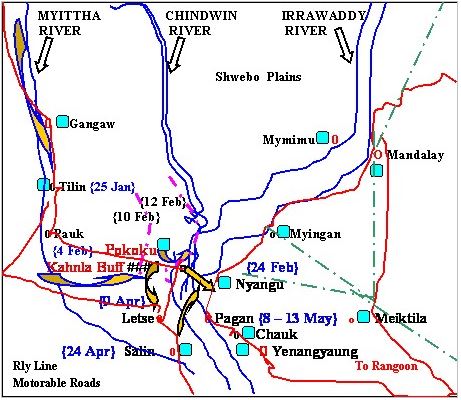Indian Army in WW2
Battle of Pakokku (Irrawady River Operations)
- Details
- Created: 23 March 2016
- Written by Brigadier Rattan Kaul
- Hits: 95854
BATTLE OF PAKOKKU (IRRAWADDY RIVER OPERATIONS)
BY
4/5 ROYAL GURKHA RIFLES (FF)
* Brigadier Rattan Kaul (4/5 Gorkha Rifles (Frontier Force))
This piece of Battalion history, which facilitated the establishment of a bridgehead across the Irrawaddy river by the Allies, is dedicated to the memory of Lt. Col. J. H. Turner, Commandant, who was injured and died of battle wounds on 12 Feb. 45 during the battle of Kahnla-Pakokku (Irrawaddy).
Preparation and Offensive Plan
By the end of July 1944, the Japanese 31st Division had been decimated at Kohima and their 33rd and 15th Division had also met the same fate, which cost the Japanese at least fifty thousand dead. In previous years, there used to be a lull during the monsoon period, but not this year (1944-45). By early December 1944, plans had been made for a general offensive during the monsoon, targeted at the pursuit of the defeated Japanese in Kohima and plains of Imphal, and another offensive along Tiddim Road and Kabaw valley, until the two thrusts joined at Kalemyo. The offensive plan thereafter centred on the occupation of Central Burma up to South of Mandalay, to destroy Japanese Forces in the Shewbo Plains, north of Irrawaddy river, where armour could be used. As per the plan, Allied forces crossed river Chindwin and the spearheads of Fourteenth Army (IV and XXXIII Corps) were moving into selected battle areas, surprising the Japanese.
The Allied Fourteenth Army was now faced with a major river obstacle (Irrawaddy), about two thousand yards broad and dotted with treacherous and shifting sand bars, covered by determined Japanese. An opposed direct crossing would have been expensive with a low percentage of success and required a surprise crossing of Irrawaddy River for fighting around Mandalay and Meiktila (see map Below). General Slim planned a move of one thrust down the Gangaw valley, to seize a bridgehead on the Irrawaddy river at Pakokku and then strike south-east with mechanised forces at Meiktila and Thazi. The operations to seize a bridgehead on Irrawaddy river at Pakokku were spearheaded by the 7th Indian Infantry Division, and initiated by 114th Indian Infantry Brigade, to which 4/5 GR (FF) belonged. First was a move by road to Tamu from Kohima, thereafter road construction of a stretch of 180 miles (over 280 kilometres) to Gangaw in 15 days. The Advance ahead from Gangaw by the Allies was to begin on 19 January 1945, with 7th Divisional tasked to seize Pauk area by 1 February 1945 as preliminary operations and then seize a bridgehead over Irrawaddy between Chauk and Pakokku by 15th February 1945. Fourteenth Army had envisaged a feint crossing of the Irrawaddy river at Pakokku by the 7th Division. On 13 February 1945, after operations at Pauk, 114 Brigade led by 4/5 GR (FF), fetched up at Tilin and appeared in front of Pakokku, achieving surprise. The Japanese sent reinforcements to these places, leaving planned crossing places lightly held. The actions of the Battalion (4/5 GR (FF)) in this operation, nicknamed Operation Capital and Extended Capital, has been described in succeeding paragraphs.
Capture of Kahnla (Pakokku)
The Battalion left Merema (near Kohima) in three parties starting 4th December 1944 and reached Tamu. The first task of the Battalion was road construction for the move of the Brigade to Gangaw (read above). By 15th January, the Battalion continued its move through Gangaw Valley and arrived at Tilin on the 25th. The Battalion had its first clash with the Japanese, since the Battle of Kohima on 29th January 1945, when a patrol from D Company clashed with the Japanese. On 3rd February, the Battalion was given its next objective; Pakokku on the Irrawaddy river. For the capture of Pakokku, the Battalion moved on 4th February. There was intermittent shelling and the Japanese were found holding a strong position at Kahnla buff (Pakokku), covering the approach to Pakokku, which was a medium sized village on the southern side of Irrawaddy river. The main defences of Pakokku were based on Kahnla, just ahead of the town, which dominated the entry to Pakokku village. Any operation towards the river would necessitate securing Kahnla buff first followed by Pakokku village. On 5th Feb, A Company (Captain Fisher), D Company (Major Brown, MC*) and Commanding Officer (CO) Lieutenant-Colonel J. H. Turner's Group made encircling move of Kahnla from the north. The Kahnla position was hardly 200 yards ahead, when troops came under heavy fire. A Company moved further left and attacked from the north-east, while D Company forming up in Kahnla village for the attack from the West; fought its way, overran half of the Japanese position, including a strong Medium Machine Gun (MMG) bunker. Not less than 30 Japanese were killed and many wounded, while two Medium Machine Guns (MMGs), three Light Machine Guns (LMGs) and twenty rifles were recovered. One of the Battalion's wounded was CHM Bhagta Bahadur Gurung, whose outstanding courage and leadership in this attack brought him a well-earned Indian Order of Merit (IOM). Major I. M. Brown MC** was awarded one more Bar to MC (Military Cross). These were two of the 41 major awards won by the Battalion during operations in the Burma Theatre during World War II. The assault and further reconnaissance on 6th February indicated that the remainder objective was strongly held. On 7th, 4/1 Gurkha Rifles established a firm base for the Battalion and on 8th February, D Company (Brown) cleared another Japanese position, killing twelve and wounding three Japanese. The main attack was planned for 10th February at 6-45 AM. Adverse weather conditions precluded preparatory air bombardment and the assault began with C Company (Beytagh) and tanks of the Gordon Highlanders. Troops charged and in spite of the tank fire support, own causalities in one platoon were nearly fifty percent. A Company (Fisher) was immediately pressed into assault in the rear of the position from the east, while D Company (Brown) assaulted onto the right of the C Company, with tanks in support. Commandant Lieutenant-Colonel J. H. Turner had hardly given these orders when he was hit by a sniper bullet and Major D. E. Owen, Second-in-Command, took over.
Sketch showing operations of 4/5 Royal Gurkhas at Pakokku and Irrawady river
3rd February to 13th May, 1945
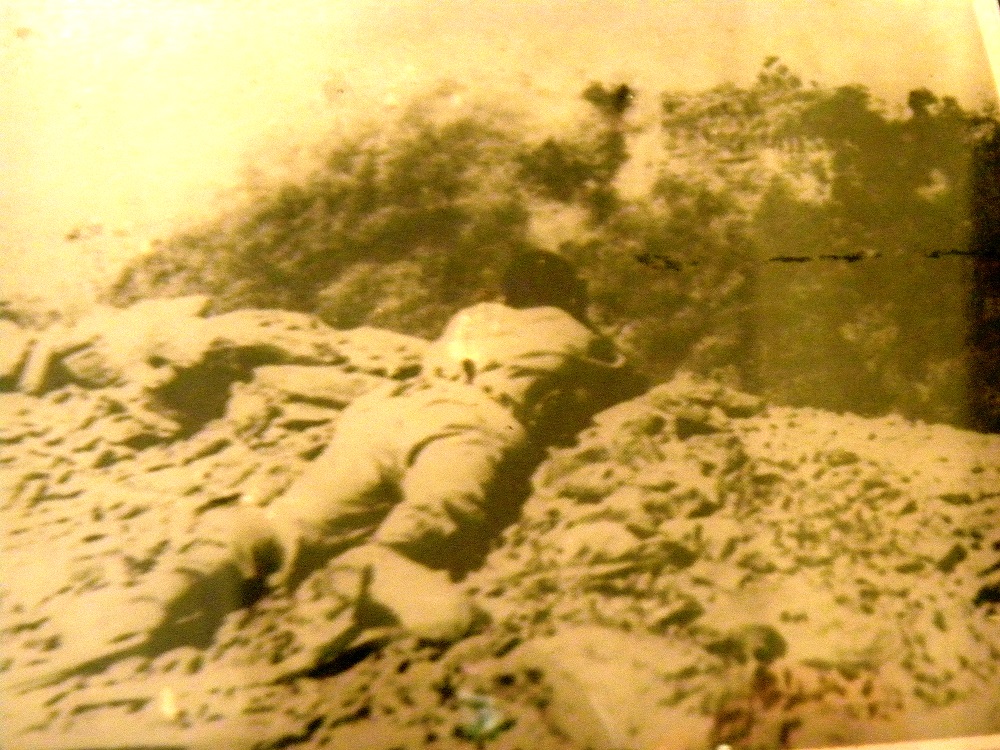
Battle of Kahnla Buff
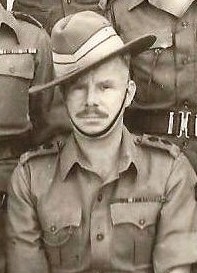
Lt. Col. A. D. MacConachie
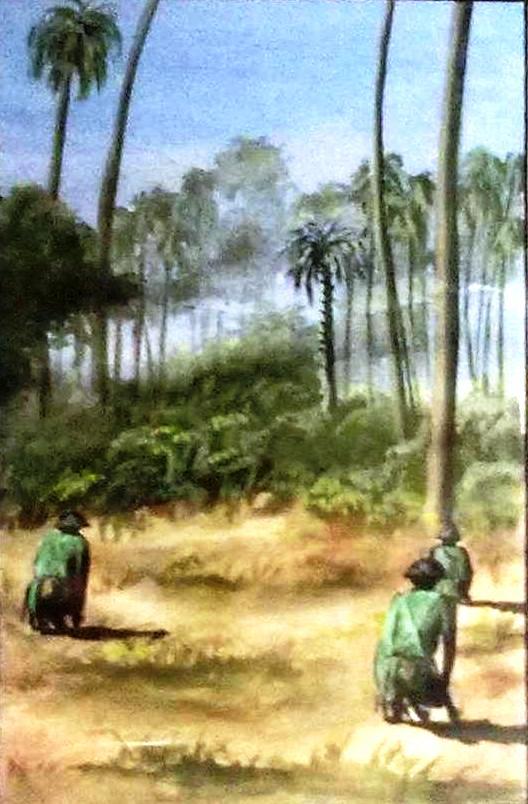
Miniature painting showing Battalion troops entering Pakokku - 13th February 1945
(Original photograph courtesy War Department, His Majesty's Government - Golden Arrow - 7th Indian Infantry Division)
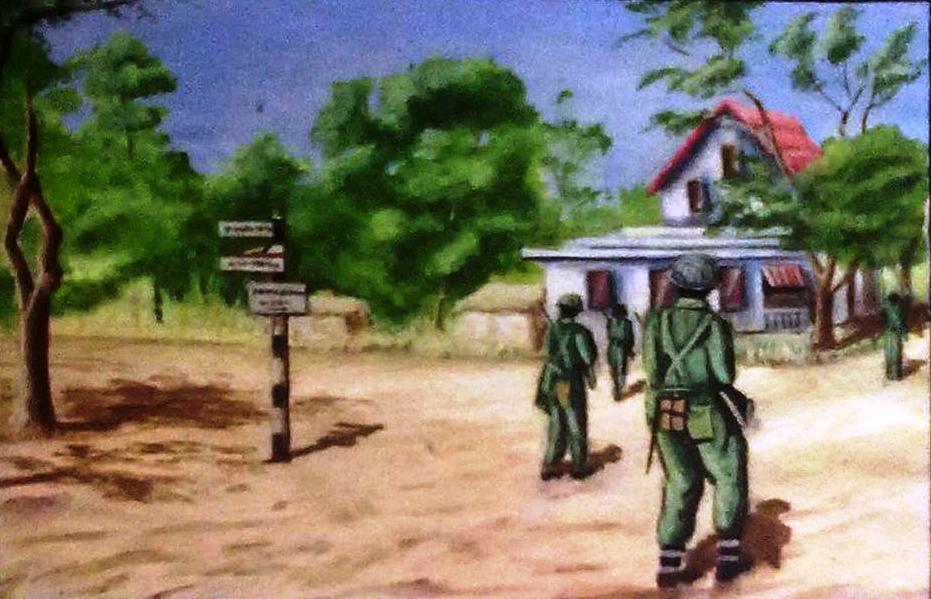
Miniature painting showing Battalion troops entering Pakokku - 13th February 1945
(Original photograph courtesy War Department, His Majesty's Government - Golden Arrow - 7th Indian Infantry Division)
Resistance by the Japanese position, defended by a battalion, was fanatical; they fought until death; only one POW was taken and fifty-one bodies counted. The objective was fully captured by the afternoon of 10th February. The whole Battalion reorganised on the objective, which had been held by a Japanese battalion. During the night of 10th/11th February, the Japanese launched six unsuccessful counterattacks. Lieutenant-Colonel J. H. Turner died the next day due to battle wounds. Lieutenant-Colonel Turner had earned respect of his men with his quick grasp of the situation and prompt decisions during successful assaults on Kahnla (Pakokku), which he was not spared to see. His coolness, particularly under heavy fire, prior to the assault at Kahnla (Pakokku) was a fine example.
On the night of 11th/12th February, the Japanese unsuccessfully tried to infiltrate into the Battalion position. On the night of 13th February, B Company (McBride) and C Company (Beytagh) occupied a position closer to Pakokku village, called Sinlan. The Battalion then finally occupied the northern portion of Pakokku. With this operation, unique as it was, decimating nearly a battalion strength of Japanese, the first stage of 7 Indian Infantry Division task was completed and a foothold gained on the west bank of the Irrawaddy river. The operation was a magnificent stroke of bravery and deception, making possible the next phase of general offensive for the destruction of the Japanese in Burma. Equipment captured included one 75 mm. gun (Now with the Centre- 58 GTC) and one Medium Machine and One Light Machine Gun. The Medium Machine Gun was held by 58 GTC as a War Trophy and taken back by the Battalion. This is prominently displayed now in the Battalion Quarter guard. Battalion casualties were five killed and twenty six wounded.
Irrawady River Bridgehead Operations
On 14th February, when the Battalion had captured Pakokku, with the achievement of surprise, the remainder of the forces made a surprise crossing and secured a bridgehead at Nyungu, just north of the ancient Burmese capital of Pagan. The role of the 7th Division hinged around the Battalion's task of the capture of Pakokku, which opened the way for 17th Indian Infantry Division operations. Everything possible had been done to make the Japanese believe that a crossing of Irrawaddy would be made at Pakokku. On 18th February Lieutenant-Colonel A. D. MacConachie from 7th Gurkhas arrived in the evening and took over command of the Battalion from Major D. E. Owen. On 19th February, the Battalion was ordered to clear an island in the Irrawaddy river lying off Pakokku, fire from which was interfering with forward movement. The island was five miles long and three miles broad, quite flat with small villages, paddy fields, clumps of trees and elephant grass. A Company (Fisher) and B Company (McBride) cleared the east and south portion of the island towards Pakokku. D Company (Brown) was held up by intense fire from well dug Japanese and C Company (Beytagh) then moved forward, cleared and occupied the position. With all the enemy positions cleared, the Battalion concentrated back at Pakokku. On 20th February, allied forces crossed the river and captured Meiktila. On the 24thm the Battalion moved south from Pakokku, crossed Irrawaddy river and took over part of the Nyungu bridgehead.
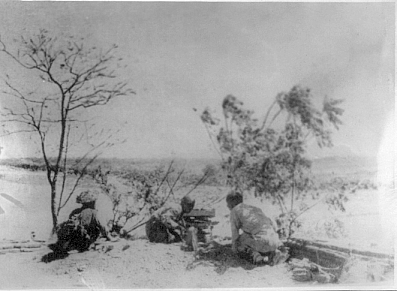
Gun Detachment of 4/5 Gurkha Rifles (FF) on the banks of the Irrawady river (Pakokku), February 1945
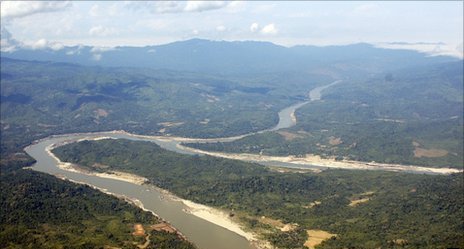
Irrawady river in the area of Battalion operations, with the island in the foreground
Operations South of Irrawady River
After three weeks of stay and patrolling at the bridgehead, the Battalion was ordered to clear the Japanese position at Kyaukpadaung road, some eleven miles south-east of Pagan, at a village named Myauke Ngaliang. A Squadron of 116th Regiment RAC (Gordon Highlanders) supported the assault by the Battalion less two Companies (B and D) on 16th March. The Japanese had dug in on the banks of an artificial reservoir, which was cleared by Guerrilla (Commando) Platoon and a troop of tanks under Lieutenant Buckley, while A Company under Major D. E. Owen, Second-in-Command, prepared to capture the village. Since the Japanese had constructed their defences inside the village, in the houses, it was decided to destroy them to force out Japanese. The village was soon secured, in which seven Japanese including an officer were killed. The Battalion remained in the Nyungu though Japanese maintained pressure against the bridgehead.
On the west bank of Irrawaddy, 28 East African Brigade had moved south to make a feint crossing in Chauk Area (see map). The reaction by the Japanese was violent and the situation was stabilised by the move of a battalion (4/14th Punjab) of the brigade to the area, while the remainder of the brigade (114th) was ordered to move to Letse to drive out the Japanese. The Battalion moved on 7th April to Letse, following 2nd South Lancashire Regiment, while the information about the Japanese was scanty. The Battalion and other units of the brigade reached/secured Letse on 9th April. On 18th April, the Battalion was on the move again on the heels of retreating Japanese. The move continued uninterrupted for 4 days and on 21st/22nd April, Seikpyu was secured. A search disclosed only one badly wounded Japanese, who died during the night. On the morning of 22nd April, a reconnaissance party under Subedar Anaram crossed Irrawaddy River in a small boat, to gain contact with troops advancing down the East Bank. As they approached Chauk (see map) they were fired upon, much to their indignation, by their own British troops. The mistake was understandable as, owing to the unbearable heat and humidity, they had stripped to the waist and the naked Gurkha torso is by no means different from that of the Japanese. The advance continued on 23rd April and in the night till north of Salin. On the morning of 24th, the move was resumed along a ridge with a prominent Golden Pagoda and a monastery and soon, the leading troops were pinned down. The opposition was cleared supported by heavy artillery concentration, while two (C and D) Companies were to continue their advance from a flank and block the road from the rear. The whole position was captured, but not before the Japanese had given a determined fight. Thirty-nine Japanese bodies were recovered. The Battalion too had suffered nine dead and ten wounded. The next day (25th), the advance was resumed. Even the administrative company column under Captains Mackenzie and Nunn ran into three Japanese, killed two and wounded the third. A rifleman of D Company, catching a fleeting glimpse of a Japanese Officer, gave chase and caught and bayoneted his quarry. On 30th April, the Battalion reached Pwinbu without any further incident and remained there till 3rd May, when ordered to move and clear another Japanese position at Pagan village. On 5th May, heavy opposition was met and B Company was held up, wounding the company commander (Maycock) and his second-in-command, Subedar Harka Bahadur Pun (He was awarded the Military Cross for his bravery). Meanwhile, D Company (Lieutenant Singleton) cleared part of the position and two companies (C and D) put a ring around the position from the south, and by 6th evening, with a roadblock in the rear on 7th. Plans were made, executed and Pagan, ancient capital of Burma, secured.
Victory
While these subsidiary operations, minor in comparison, had been taking place west of the Irrawaddy river, the Battle of Mandalay had been fought. The Japanese had been decisively and finally beaten. The Japanese Army in Burma, except for those still east of Sittang River, had ceased to exist as an organised and integrated force. On 2nd May 1945, Rangoon had been reoccupied and General Slim's plans had been brought to a triumphant conclusion. The monsoon was about to break and the next phase was to be a large scale mopping up operations. On 14th May, the Battalion left Pagan and arrived at Allanmyo. Orders were received on 27th May to move to Prome for further operational tasks around Sittang River.
Irrawady was awarded as Battle Honour to the Battalion
